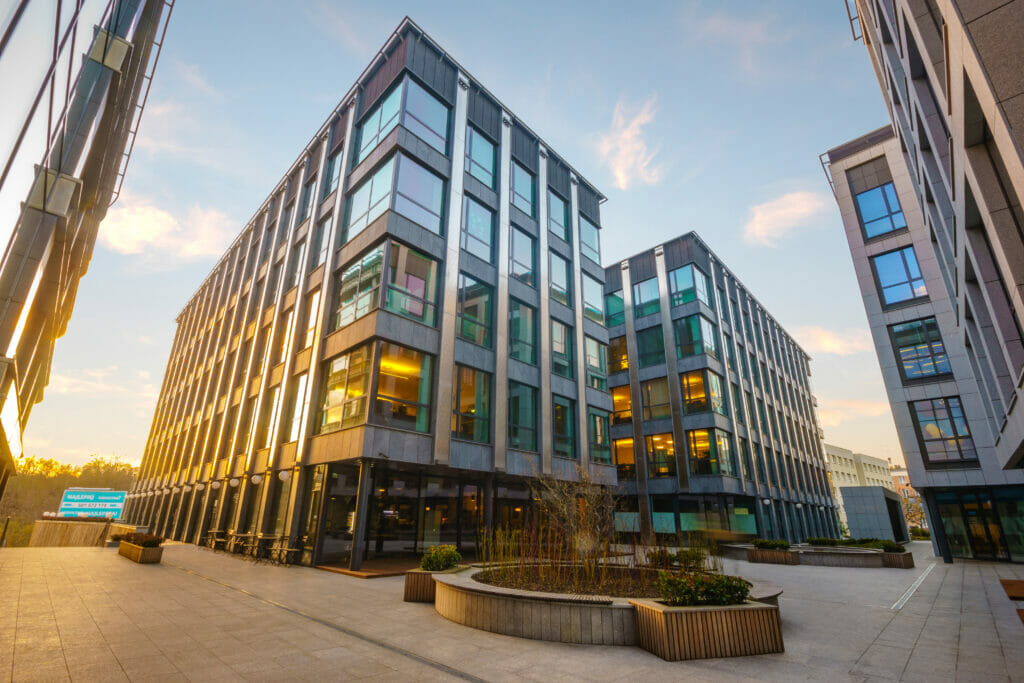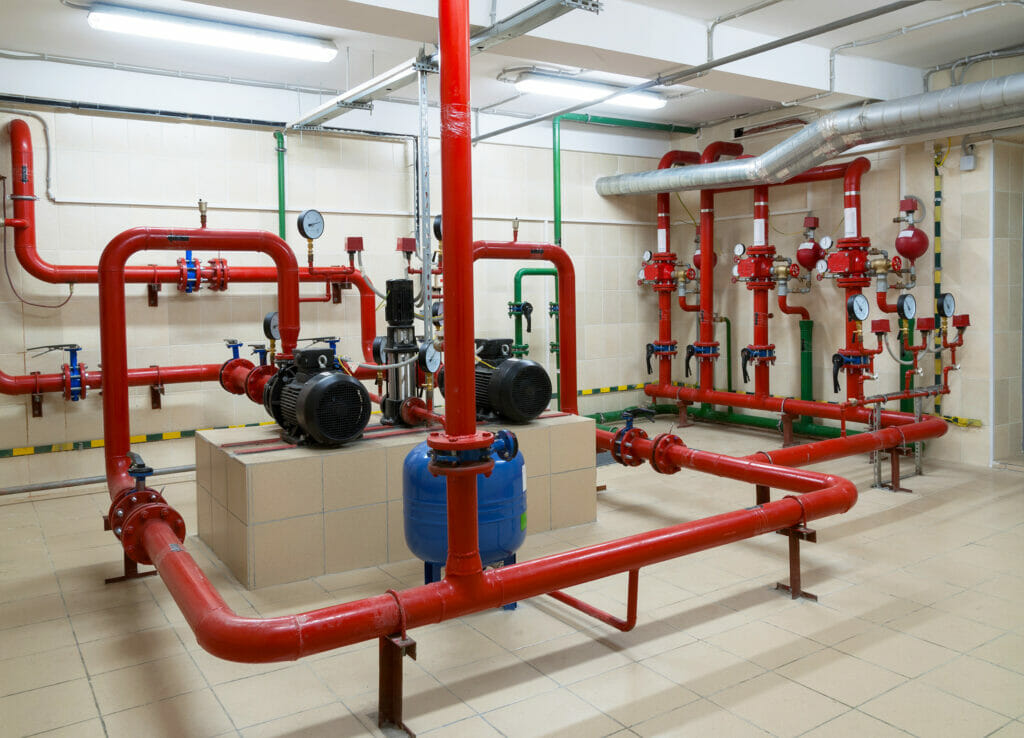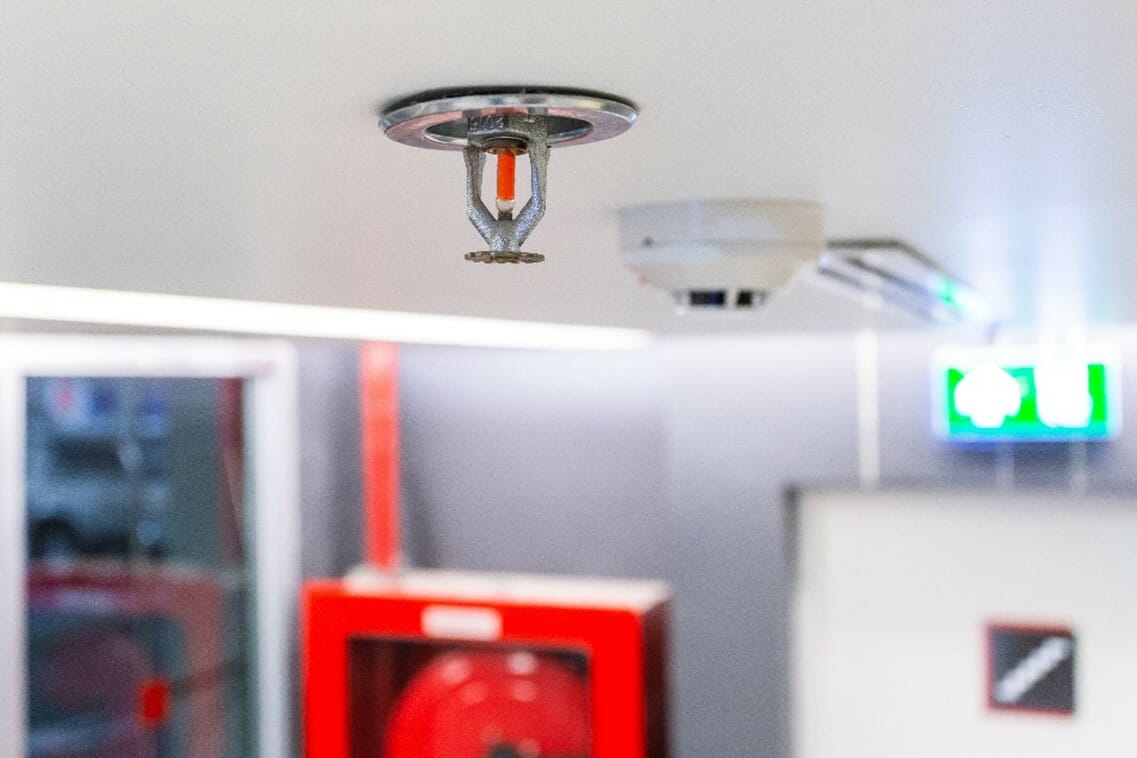Automatic suppression systems are designed to react to a fire and either extinguish or control it such that extinguishment can be completed by other means. There are several different types of suppression systems, with the most familiar and widespread being water sprinkler systems.
Sprinkler systems typically consist of a water tank, pumps, valves, arrays of pipework, and sprinkler heads. Their operation is most effective during the initial stages of a fire’s development, where the fire growth is disrupted by wetting surrounding combustible materials and smothering flames through evaporation. It is for this reason that sprinklers are effective at safeguarding evacuation and protecting property. Evidence demonstrating the effectiveness of sprinkler systems is well-accepted globally and it would be difficult to find anyone arguing that they are not one of the most effective fire safety provisions available. As an example, UK research commissioned by The National Fire Chiefs Council identified that the operational reliability of sprinkler systems was 94% and they were 99% effective in controlling or extinguishing fires.[1].
In the UK, current fire safety guidance recommends that sprinklers are provided in non-residential buildings that are over 30 metres in height (roughly equating to buildings with at least nine storeys). As such, low and medium-rise non-residential buildings are often not fitted with sprinklers.
Therefore, whilst sprinkler protection is considered to be highly efficient at minimising the consequences of a fire, it might appear surprising that they are not installed in most buildings in the UK. Could the fire safety industry be doing more to encourage their installation in low and medium-rise buildings?
Based on my professional experience as a fire engineer advising on fire-safety decision-making during various stages of a building’s design and construction, there are two common reasons that discourage stakeholders from installing sprinklers within low and medium-rise non-residential buildings. These are the spatial requirements and the costs associated with such systems. In this article, I evaluate both factors and question whether current sprinkler design guidance is demanding systems that are “too good”, i.e. with a performance that could be reduced so that smaller and more cost-effective solutions could be installed in more buildings, whilst still being effective.

Spatial Requirements
A frequent concern I have heard in the design of sprinkler systems is related to the space requirements for the water tank. This is significant, as designers seek to maximise the commercial value of buildings by proportioning as much space as possible as saleable area. Furthermore, as buildings continue to increase in complexity and usability, physical space for plant equipment is at a premium.
The design of non-residential automatic sprinkler systems typically follows the recommendations found in BS EN 12845. With reference to this guidance, and assuming parameters associated with typical buildings (e.g. less than 18 metres in height and containing similar fire hazards as those which can be found in a hotel or office etc.), a pre-calculated minimum effective water volume of 55,000 litres is advised. Allowing for any inefficiencies of the tank volume, that equates to a tank with approximate dimensions of 6m x 6m x 2m, not allowing for additional surrounding space for the associated pumps and fittings, and maintenance access.

That is a significant footprint for designers to locate, particularly within buildings that might be seven storeys or less. The appetite to include such a sprinkler system is made especially more difficult when there is little regulatory pressure for such buildings to have automatic suppression at all. So, is this demand for water storage proportionate? Could it be possible to reduce tank sizes, maintain adequate sprinkler performance in a fire, and encourage more installations?
To explore this, I refer to evidence that shows that 95% of fires are suppressed with five or less[2] sprinkler heads operating; and BAFSA guidance which states that a single sprinkler head discharges up to 100 litres per minute. Combining this information results in a generous flow rate estimate of 500 litres per minute, demanded by a sprinkler system during a fire.
At this flowrate, water from a tank with an effective capacity of 55,000 litres can suppress a fire for 1 hour and 50 minutes. This is a considerable duration for a fire, before which it could be expected that both the Fire Service will have intervened and the full evacuation of a typical building to have completed.
It could be argued that a timeframe of 30 minutes might be more appropriate. This should ensure protection during the most critical stages of fire development, and beyond such point that the Fire Service are likely to have attended and begun to extinguish a suppressed fire. Such a sprinkler system duration should be sustainable from a tank with an effective capacity of 15,000 litres; which would occupy approximately 3.5m x 3m x 2m. In comparison to the pre-calculated system from BS EN 12845 this represents a 51m3 saving of vital building space.
This demonstrates that it might be possible to provide more optimal sprinkler systems that still have adequate fire safety performance, but present less of a hinderance to the usability and commerciality of a building. This could make the installation of sprinklers a more attractive proposition to building designers and developers, and increase the propensity for sprinklers to be installed in buildings that otherwise might have had no fire suppression at all.
I should acknowledge other methods, acceptable in the design guidance, which can also help to reduce the pre-calculated tank size. For instance, it is possible to hydraulically calculate the system to identify more bespoke sizing, utilise towns mains as the water source, share tanks with other buildings or install water mist suppression systems. However, in my experience these each have their own pitfalls: hydraulic calculations can still demand sizable tanks; water suppliers will not guarantee the water flows and pressures necessary for towns mains support, water mist systems are relatively new and therefore introduce approvals risks with Building Control and Insurers; and shared tanks between different operators is a novel idea with issues relating to maintenance and responsibility.
Cost
A second common concern is the up-front capital cost.
It is true that initial costs associated with equipment and installation can be considerable. However, in my experience, the flexibility in the fire safety design of buildings that incorporate sprinkler systems is often overlooked. For example, sprinklers can allow a reduction in the level of fire resistance of walls, floors, and elements of the structure. This can introduce significant cost savings (and often environmental benefits).
Equally notable is that the provision of sprinklers can greatly assist the Building Regulation approvals process; Authorities Having Jurisdiction (including the Fire Service) unsurprisingly view the inclusion of a sprinkler system favourably. A more efficient building approvals procedure can make a considerable difference to cost, as any redesign or technical justification can become expensive, especially at the latter stages of a project programme when the design is largely fixed.
It should also be noted that any advancements towards reducing sprinkler tank sizes, as discussed above, would also mean lower up-front capital costs. Not only are smaller tanks cheaper assets, but the associated pumps and pipework are also likely to be more cost-effective.
Conclusion
This article seeks to discuss the benefits of sprinkler systems and ways in which they could be introduced into more buildings; I question whether current sprinkler design guidance is demanding systems that are “too good” and, by doing so, could be inadvertently reducing the number of buildings that could benefit from effective sprinkler protection.
It might be possible that, by relaxing current design guidance somewhat, particularly in relation to tank sizing, we might be able to gain sprinkler protection within buildings that previously would not have any. Overall, this could reduce the societal risk from fire and decrease the losses sustained from such incidents.
About the Author
Since joining Hawkins’ Birmingham office in 2022, Tom has utilised his fire safety experience to conduct investigations into the fire engineering design, construction and management of a range of building types. These investigations allow Tom to advise on proportional remediation measures to ensure fire risk levels are managed; and/or identify any relevant breaches in legislation that might have contributed to fire damage.
[1][2] National Fire Chiefs Council. Efficiency and Effectiveness of Sprinkler Systems in the United Kingdom: An Analysis from Fire Service Data. May 2017







